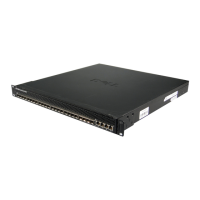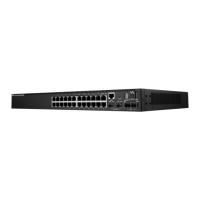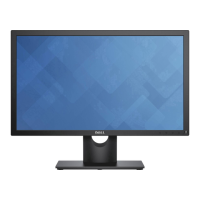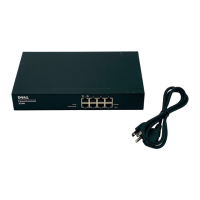826 Configuring Data Center Bridging Features
FIP Snooping
The FCoE Initialization Protocol (FIP) is used to perform the functions of
FC_BB_E device discovery, initialization, and maintenance. FIP uses a
separate EtherType from FCoE to distinguish discovery, initialization, and
maintenance traffic from other FCoE traffic. FIP frames are standard
Ethernet size (1518 Byte 802.1q frame), whereas FCoE frames are a
maximum of 2240 bytes. FIP Snooping is supported on the PC80xx switches.
FIP snooping is a frame inspection method used by FIP Snooping Bridges to
monitor FIP frames and apply policies based upon the L2 header information
in those frames.
FIP snooping allows for:
• Auto configuration of Ethernet ACLs based on information in the
Ethernet headers of FIP frames.
• Emulation of FC point-to-point links within the DCB Ethernet network.
• Enhanced FCoE security/robustness by preventing FCoE MAC spoofing.
The role of FIP snooping-enabled ports on the switch falls under one of the
following types:
• Perimeter or Edge port (connected directly to a Fibre Channel end node or
ENode).
• Fibre Channel forwarder (FCF) facing port (that receives traffic from
FCFs targeted to the ENodes).
The default port role in an FCoE-enabled VLAN is as a perimeter port. FCF-
facing ports are configured by the user.
Enabling and Disabling FIP Snooping
When FIP snooping is globally enabled on the switch, FC-BB-5 Annex D
ACLs are installed on the switch, and FIP frames are snooped. FIP snooping
will not allow FIP or FCoE frames to be forwarded over a port until the port is
operationally enabled for PFC. VLAN tagging must be enabled on the
interface in order to carry the dot1p values through the network. Establishing
NOTE: The PowerConnect 8024/8024F FIP Snooping Bridge feature supports the
configuration of the perimeter port role and FCF-facing port roles and is intended
for use only at the edge of the switched network.
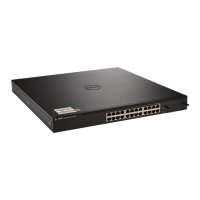
